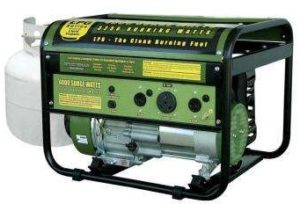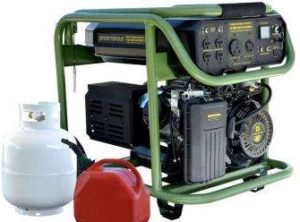Many people move into the country thinking they will live off-grid and be a kind of frontiersman or woman. Although we would like to be completely self-sufficient, it is a long road to get there and there are lots of holes along the way. As we move in that direction, we want to be prepared for emergencies, such as hurricanes and the power outages they often create.
Florida’s location on the Gulf of Mexico, with its warm water, and across the Atlantic from Africa makes it a prime target for tropical storms and hurricanes. Our “hurricane season” lasts from June to November and brings lots of rain and thunderstorms to our area, even if they are not hurricanes. Until I started living here, I was not fully aware of the amount of rain that this region gets on a regular basis.
Along with copious amounts of rain, we have had a number of power outages, but most only last a few hours. Sometimes, such as while I am writing this blog, the internet goes out and the power stays on. It is inconvenient but not unbearable. However, when it happens during a weekday it also stops my online tutoring and reduces my income from that.
One way to deal with power outages is with a portable generator. We have two: one that is small enough to move around easily that can power a refrigerator, fans, and small appliances or recharge laptops and a second that is big enough to run our well and most of the house excluding the air conditioner. When we had the house built, we asked the propane company to run a line to the wall where our power meter is located, so that the generator could access our propane tank. Our builder had the electrician put a transfer switch there also.


After we moved in, we contacted the propane company about hooking up our dryer and providing a connector for the generator. We got the dryer hooked up, but the guy who did it seemed to think that we needed to connect our generator closer to the tank for it to work. At least, we still had the transfer switch. We decided to try out the generator/transfer switch combination at the end of March using a portable propane tank.
The directions for properly using the transfer switch are posted next to where it is located. If you use one of these, it’s important to follow the steps so that you don’t send power in the opposite direction where it could electrocute someone. Needless to say, we didn’t want that to happen. We turned on the generator, did the steps in sequence, and attempted to run the power through the main panel in our house.
I was really surprised that there were pops and circuit breakers that would not stay engaged. Some lights went on, but our experiment was not successful. That was on a Saturday evening. We didn’t find out the extent of its failure until late the next day after we returned from visiting a friend. Our expensive, new refrigerator with its electronic system was not cooling although the lights inside it still worked.
We put our perishables from the refrigerator and freezer food into coolers with bags of ice and I started calling repair companies early on Monday to find someone who could fix the fridge. We finally got someone to come out and his diagnosis was that the electronic panels had been completely knocked out! On top of that, it would likely take six weeks to get the circuit boards needed to repair it and only once they had been installed could the full extent of the damage be determined. We paid for the service call and waited to find out how soon we could get the replacement parts.
I also started looking for another refrigerator! It was obvious to me that the fully electronic ones were a little too fragile for my tastes, so I tried to find something that would not be so easily broken. By Wednesday, I had found an American-made fridge that would do the trick and sent my husband over to the store to pick it up. They helped him load it into his pickup truck and with some boards for a ramp, my husband and I were able to unload it. It was a whole other job to get it up the stairs to the house!

I called our closest neighbors and asked if they could help. Luckily, they added three grown men to our team to move the fridge upstairs and the job was accomplished without anyone getting injured. We thanked our neighbors and shared some freeze-dried bananas with them as a bonus. We now had two full-size refrigerators in our kitchen and the dining table didn’t fit the remaining space. It got moved to the other side of our kitchen island until we could get the original fridge repaired.
After a few weeks of waiting, I called the company whose tech had diagnosed the problem. I asked about the parts. I was told they couldn’t get them and if we wanted the fridge repaired, we could find someone else to do it! I asked for the names and numbers of the parts needed. We located a supplier online and had them shipped to us. We installed the parts but didn’t have the codes needed to program them to work for the computer. Then I found a certified tech that the manufacturer’s company recommended and set up an appointment for their tech to come out.
The certified tech used the codes and told us to wait 24 hours before we tried to move anything over to the refrigerator as it needed to cool down first. After a day passed, the freezer section was at the right temperature, but the refrigerator would not cool down to the recommended temperature. I called the repair company again and explained the situation. We had to wait another week for the tech to be in our area again.
The next time he came out, we were told that the fan was not sending cold air from the freezer to the fridge. Unfortunately, he did not have the fan in his truck, so we had to wait another week for him to come out again with that part. Once the fan was installed, we were assured the refrigerator would work, but again it would not cool down to the required temperature. Another call, another visit, this time we were told the fan and one of the electronic panels we purchased were not communicating with each other and needed to be replaced.
We ordered the replacement part for the electronic board we got, and the company did the same for the fan. There was another wait for the parts to come in and then to schedule the tech again. After these were replaced and before he left, we made sure the temperature was going down inside the refrigerator! Now we have two working refrigerators in the house!
What about the generator? We did get it hooked up with a connector from our propane company and it worked fine. Then a friend familiar with generators came out to help me determine which circuits I could use with it. The same popping noises happened. He checked the voltage coming to the main panel and found it was 240 V not 120 V. This was where the power surge had come from that knocked out the electronics in the fridge!
I contacted my general contractor and we are now waiting for the electrician who botched the transfer switch to come out and fix it! I want them to pay for the repairs to my fridge also!
Part 2 – Caterpillar Invasion!

It’s a story of learning that each little bit is important and that good workmanship can be hard to find. I’m glad you got it sorted out finally and having two fridges might come in hand once we have some full size harvests happening. I like the potentials of two fridges full of ingredients to work with. Best, Your Chef
Well, if that contractor values clean comments on Google Reviews about his business, he had best replace your refrigerator and pay other damages.
He may be on Angies List or Yelp too. I would use that as a tool to get him to comply.
ML,
Brenda
Thanks, Brenda! The original electricians did give us $500 to offset the cost of the repairs, but not the new fridge we had to buy. At least now we have two fridges and freezers if we need them.